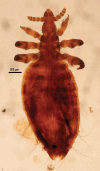The microbiome of the sucking louse Linognathus stenopsis (Phthiraptera, Anoplura, Linognathiidae)
- PMID: 40569810
- PMCID: PMC12271732
- DOI: 10.1093/jme/tjaf060
The microbiome of the sucking louse Linognathus stenopsis (Phthiraptera, Anoplura, Linognathiidae)
Keywords: Linognathus stenopsis; Anoplura; microbiome.
Figures






Similar articles
-
An annotated checklist of sucking lice (Phthiraptera: Anoplura) from domestic and wild mammals in Malaysia, with lists of hosts and pathogens.Zootaxa. 2022 Dec 2;5214(3):301-336. doi: 10.11646/zootaxa.5214.3.1. Zootaxa. 2022. PMID: 37044900
-
Survey on blood-sucking lice (Phthiraptera: Anoplura) of ruminants and pigs with molecular detection of Anaplasma and Rickettsia spp.Vet Parasitol. 2010 Dec 15;174(3-4):355-8. doi: 10.1016/j.vetpar.2010.09.003. Epub 2010 Sep 15. Vet Parasitol. 2010. PMID: 20943320
-
A new species of sucking louse (Phthiraptera: Anoplura: Linognathidae) from Günther's Dikdik (Madoqua guentheri) in Kenya.J Parasitol. 2015 Apr;101(2):140-4. doi: 10.1645/14-616.1. Epub 2014 Nov 13. J Parasitol. 2015. PMID: 25394219
-
An update on the occurrence of flies (Diptera: Muscidae, Calliphoridae) and sucking lice (Phthiraptera: Anoplura) of veterinary importance in Malta: First record of Lucilia cuprina and Linognathus africanus.Front Vet Sci. 2023 Mar 14;10:1143800. doi: 10.3389/fvets.2023.1143800. eCollection 2023. Front Vet Sci. 2023. PMID: 36998639 Free PMC article.
-
Review of the systematics, biology and ecology of lice from pinnipeds and river otters (Insecta: Phthiraptera: Anoplura: Echinophthiriidae).Zootaxa. 2013;3630:445-66. doi: 10.11646/zootaxa.3630.3.3. Zootaxa. 2013. PMID: 26131525 Review.
References
-
- Adeolu M, Alnajar S, Naushad SS, et al. 2016. Genome-based phylogeny and taxonomy of the ‘Enterobacteriales’: proposal for Enterobacterales ord. nov. divided into the families Enterobacteriaceae, Erwiniaceae fam. nov., Pectobacteriaceae fam. nov., Yersiniaceae fam. nov., Hafniaceae fam. nov., Morganellaceae fam. nov., and Budviciaceae fam. nov. Int. J. Syst. Evol. Microbiol. 66:5575–5599. https://doi.org/ 10.1099/ijsem.0.001485 - DOI - PubMed
-
- Alarcón ME, Polo PG, Akyüz SN, et al. 2022. Evolution and ontogeny of bacteriocytes in insects. Front. Physiol. 13:1034066. https://doi.org/ 10.3389/fphys.2022.1034066 - DOI - PMC - PubMed
-
- Balados-González GG, Martínez-Hernández JM, Martínez-Rodríguez PB, et al. 2023. Molecular detection of hemotropic Mycoplasma and Bartonella species in lice from sheep and goats of Mexico. Vet. Parasitol. Reg. Stud. Rep. 44:100921. https://doi.org/ 10.1016/j.vprsr.2023.100921 - DOI - PubMed
-
- Binetruy F, Dupraz M, Buysse M, et al. 2019. Surface sterilization methods impact measures of internal microbial diversity in ticks. Parasites Vectors. 12. https://doi.org/ 10.1186/s13071-019-3517-5 - DOI - PMC - PubMed
-
- Boyd BM. 2014. Bacterial symbiosis with parasitic lice. PhD Thesis. University of Florida.
Grants and funding
LinkOut - more resources
Full Text Sources

